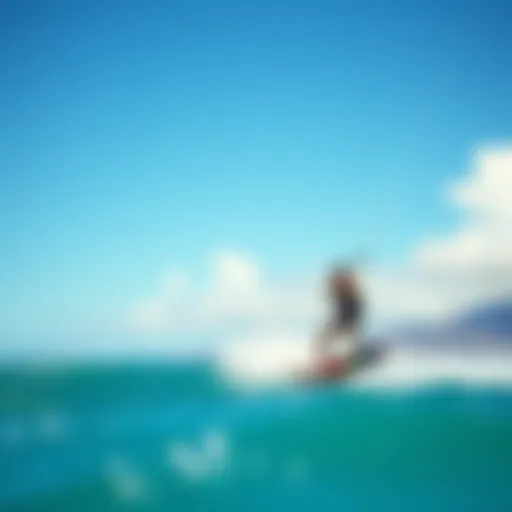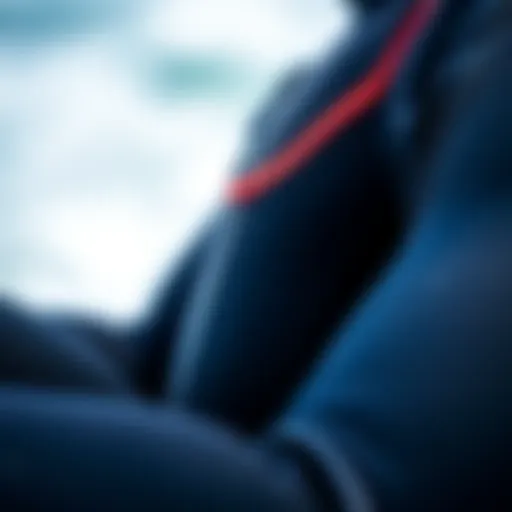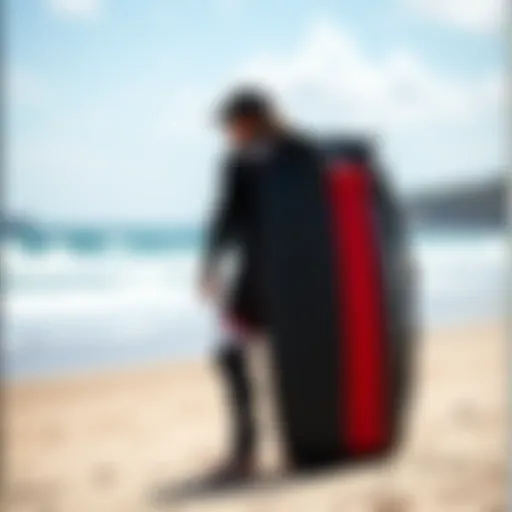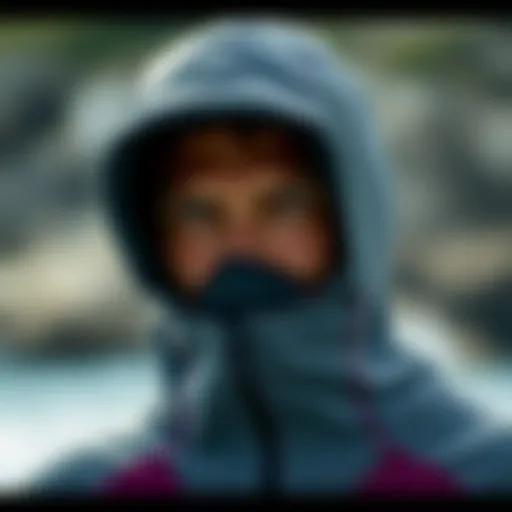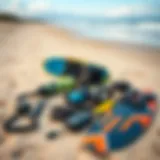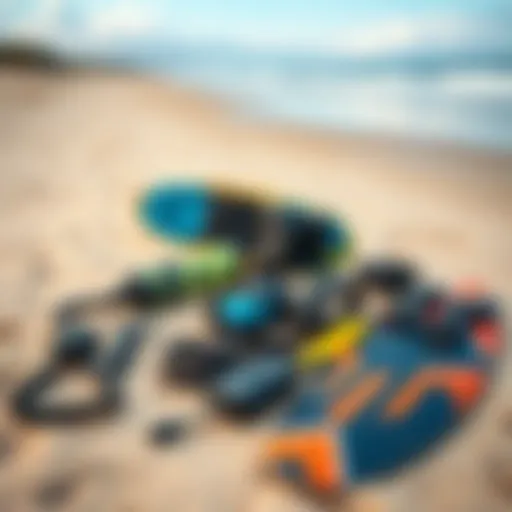Essential Wet Suit Buying Guide for Kiteboarders
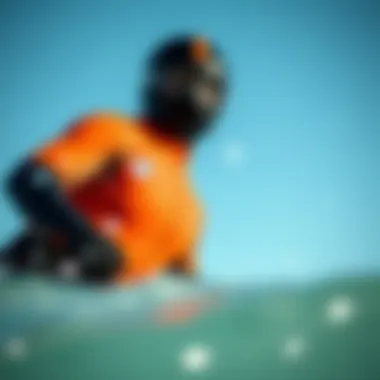
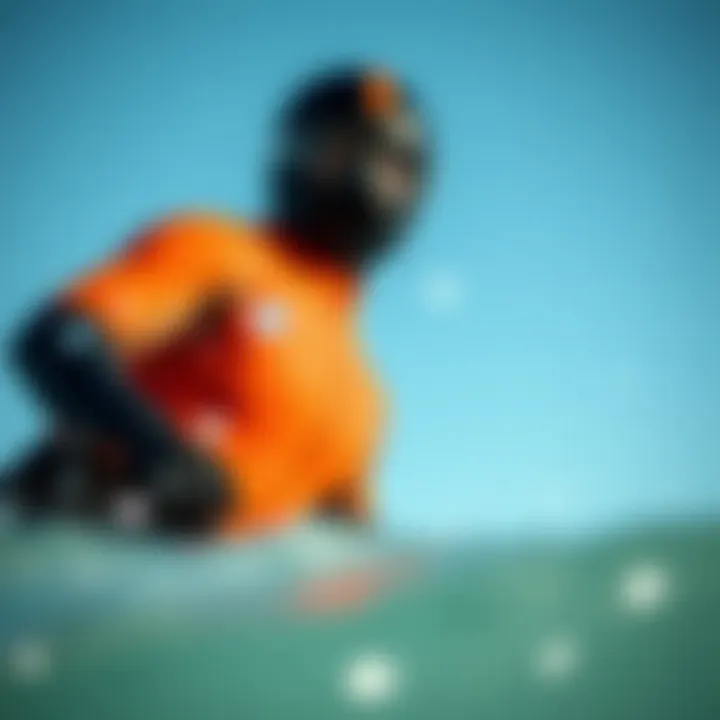
Intro
When it comes to kiteboarding, a good wet suit can be the difference between feeling like a fish in water and battling the elements. For anyone who loves the thrill of gliding across the waves, choosing the right wet suit isn't just a shopping decision—it's an investment in comfort, performance, and safety. Many enthusiasts, especially those new to the sport, often feel overwhelmed by the myriad of options available; different materials, styles, and features can complicate what should be a straightforward process. This guide aims to clarify those waters, providing a thorough understanding of what to consider when shopping for your next wet suit.
Considering factors like thermal insulation, material types, fit, and maintenance, we’ll equip you with the knowledge to make an informed choice that enhances your kiteboarding experience. Whether you're a seasoned pro or just starting out, having the right gear can help you fully enjoy your time on the water.
Gear Insights
Selecting the right wet suit is crucial for your comfort and performance on the water. Let's break down some of the key aspects to consider.
Material Types
Wet suits are primarily constructed from neoprene, a material known for its thermal insulation properties. However, not all neoprene is created equal. Here are some common types:
- Standard Neoprene: Offers reasonable warmth and flexibility but might not be suitable for extreme conditions.
- Superstretch Neoprene: This type is more flexible and allows for a greater range of motion, which is valuable for kiteboarders who need to maneuver quickly.
- Yamamoto Neoprene: Made from limestone instead of petroleum, this eco-friendly option is lightweight and offers superior insulation.
Each of these materials serves a different purpose, so consider your local conditions before making a choice. If you are prone to spending hours in cooler waters, investing in a suit made from higher-quality neoprene would be wise.
Fit Considerations
A wet suit needs to fit snugly without constricting your movements. A suit that’s too loose will allow water to rush in, negating its thermal benefits. Always try it on before buying. Key points to check:
- Neck Seal: Ensure that it provides a firm fit without choking you.
- Shoulders and Arms: You should be able to lift your arms without feeling restricted.
- Leg Length: Check that it doesn’t bunch up around your ankles.
"A wet suit that's too loose is like a good fishing line that’s frayed—no catch, just frustration."
In general, many brands have a sizing chart that can guide you, but personal fit is always best assessed in-store whenever possible.
Thermal Insulation
In kiteboarding, thermal insulation is vital—especially in colder months. Wet suits come in varied thicknesses, commonly ranging from 2mm to 6mm, each serving different temperature ranges. A 2mm suit is often suitable for warmer waters, while a 5mm suit is better for chilly climates.
Practical Features
Look for extra features that make your wet suit experience smoother. Zipper placements, added padding, or even integrated hoods can enhance functionality. It’s often the little things that make a big difference.
- Back Zips vs. Chest Zips: Back zips are easier to don and doff, while chest zips often provide better water protection.
- Finishes: Sealed seams are great for preventing water ingress, while flatlock stitching is comfortable but not as watertight.
Techniques and Tips
Once you've chosen a wet suit that fits well, you’ll want to ensure it remains in prime condition. Here are some savvy tips for maintaining its longevity:
- Rinse with Fresh Water: After each use, particularly in saltwater, rinse it in fresh water to remove salt and sand.
- Drying: Turn it inside out while drying to prevent odors and degradation. Avoid direct sunlight, as that can damage the material over time.
- Storage: Store your wet suit hanging on a wide hanger to maintain its shape.
Finale
Navigating the world of wet suits might seem overwhelming at first, especially for those new to kiteboarding. Yet, with this guide, you can tackle the shopping process with confidence. Find a suit that not only fits but caters to your specific needs, enhancing your performance and comfort out on the water. Remember: a well-chosen wet suit is not just about warmth; it's about ensuring you can focus on the thrill of your sport, rather than feeling the chill.
Understanding Wet Suits
When it comes to kiteboarding, understanding wet suits is like knowing the difference between a toy kite and a powerful performance model. Wet suits are more than just clothing; they play a fundamental role in ensuring that you maintain body heat, especially in cooler waters, while also providing flexibility and comfort. For kiteboarders, a wet suit is essential not only for warmth but also for protection against the elements, like wind and waves. The right wet suit can enhance your experience on the water, allowing freer movement and greater confidence in changing conditions.
Definition and Purpose
In simple terms, a wet suit is a specialized garment made primarily from neoprene, a type of synthetic rubber. Its purpose is to insulate the body and retain heat when submerged in water. Wet suits do this by trapping a thin layer of water between your skin and the suit, which warms up from your body heat, forming a thermal barrier. This unique feature is crucial for kiteboarders who may face chilly winds and cold ocean currents. In short, a well-fitting wet suit can transform a potentially freezing outing into a comfortable session, allowing you to focus on your performance rather than being distracted by the discomfort of the cold.
Categories of Wet Suits
Wet suits come in various styles, each with specific applications, depending on the conditions and your activities. Here’s a look at some common categories:
Full suits
Full suits are the most classic option. Designed to cover the entire body, they typically have long sleeves and legs, providing maximum warmth and protection. Their key characteristic lies in their insulation effectiveness, making them an excellent choice for colder water and air temperatures. Full suits often have added features like reinforced knees and specialized zippers to enhance durability and performance. One of the main advantages of opting for a full suit is that it allows kiteboarders to extend their sessions in less favorable conditions without fear of getting chilled or uncomfortable. However, in warmer climates, they might feel a bit restrictive and warmer than necessary.
Shorty suits
Shorty suits, or short wetsuits, are tailored for warmer conditions. They cover the torso and typically have short sleeves and legs, giving more freedom of movement. This type shines in moderate temperatures, as it's designed to keep you warm without overheating. The key feature is its versatility; it’s excellent for summer kiteboarding when the weather is warm but you still want some degree of protection. One of the biggest advantages of shorty suits is their lightweight nature, making them easy to wear and take off. However, they may not provide sufficient warmth in very cold waters, which could lead to discomfort during protracted outings.
Spray jackets
Spray jackets serve a different purpose compared to traditional wet suits. They are typically worn over a wet suit or on their own for added protection from spray and wind. Their primary characteristic is that they are lightweight and often equipped with features like a cinched waist to prevent water from sneaking in. These jackets are perfect for kiteboarders who want to be shielded against the elements without the bulk of a full wet suit. In terms of advantages, they can keep you dry and warm while still providing the flexibility required for dynamic movement on the water. However, they might not provide the same thermal insulation as a wet suit, so they aren't ideal for colder conditions without additional layering.
By understanding these categories and what they offer, kiteboarders can make an informed choice that aligns with their specific needs, ensuring a more enjoyable experience on the water. When choosing the right wet suit, consider what type of conditions you're likely to face, and select accordingly. For more on the specifics of each category, you can delve deeper into resources like Wikimedia or explore community forums on Reddit.
This foundational understanding lays the groundwork for determining the appropriate fit, materials, features, and overall care for your wet suit, which we'll explore in subsequent sections.
Material Considerations
When it comes to picking a wet suit, the type of material used is pivotal. It not only affects how well the suit performs in water but also impacts comfort, flexibility, and overall durability. In kiteboarding, where movements can be quite dynamic, the material of a wet suit plays a crucial role in ensuring that the athlete can perform at their best without being hindered by their gear. Let's dive deeper into the various materials and their characteristics.
Neoprene Types
Standard neoprene
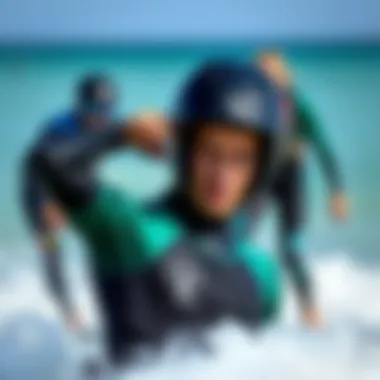
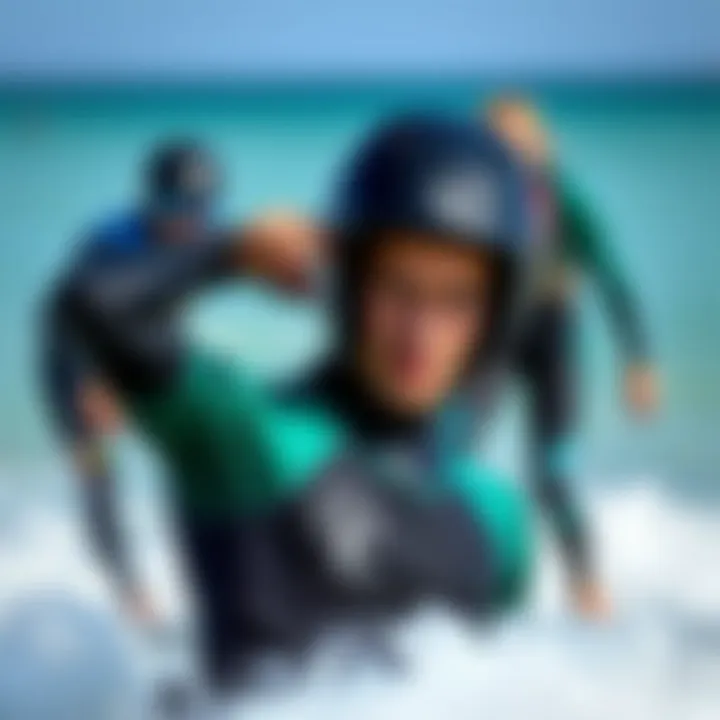
Standard neoprene is perhaps the most widespread material in the wet suit world. It's recognized for its balanced insulation and flexibility. A key characteristic of standard neoprene is its thickness, typically ranging between 3 to 5 mm, which provides adequate thermal protection in cooler waters. This makes it a go-to choice for many kiteboarders who frequent temperate climates.
Unique to standard neoprene is its moderate stretch and recovery, ensuring that it fits snugly yet allows for a decent range of motion. However, one should consider that it might feel less flexible compared to some of its more advanced counterparts, especially during extended periods of active movement. While it serves well in many scenarios, kiteboarders might find it limiting in very warm conditions due to its thickness.
Super stretch neoprene
Super stretch neoprene takes flexibility up a notch. It's engineered with additional elastic properties, leading to a material that can stretch considerably without loss of form. This feature enables greater freedom of movement, which is particularly advantageous during high-energy activities like kiteboarding.
The main allure of super stretch neoprene is that it retains warmth while allowing for optimal mobility. This means that kiteboarders can enjoy a more dynamic range of motion without feeling restricted. However, it’s worth noting that, while it provides excellent comfort, it often comes at a higher price point, which might deter those on a budget.
Eco-friendly alternatives
As awareness regarding environmental issues rises, manufacturers have started to introduce eco-friendly neoprene alternatives. These materials often use natural or recycled ingredients, aiming to reduce the environmental footprint of wet suits.
A striking aspect of eco-friendly alternatives is their commitment to sustainability without significant compromise on performance. They boast similar thermal properties and flexibility as traditional neoprene but come with the added benefit of being more environmentally conscious. However, one must keep a keen eye on their longevity, as some eco-friendly options may not hold up as well against wear and tear as their traditional counterparts.
Thickness and Insulation
Selecting the right thickness in a wet suit is another essential consideration for kiteboarders. Thickness directly affects insulation and warmth, which are critical factors when navigating varying water temperatures.
Choosing the right thickness
Choosing the right thickness for a wet suit often relies on the specific conditions and personal comfort levels. Typical options range from 2 mm for warmer climates to 5 mm or more for colder waters. A thicker suit provides better insulation but can limit mobility. Therefore, it is crucial for kiteboarders to reflect on the water temperature they will be diving into and choose accordingly. In temperate conditions, a 3 mm suit might suffice, while colder environments might necessitate a thicker alternative.
The unique feature to consider in thickness is its balance between mobility and warmth. Although a thicker suit can restrict movement slightly, the warmth it offers may outweigh this downside during colder sessions. Keeping these variables in mind can lead to a more enjoyable kiteboarding experience.
Impact of water temperature
Water temperature is a vital aspect that influences the choice of wet suit thickness. Colder waters, typically below 65°F (18°C), may require suits that offer additional insulation to prevent hypothermia during extended sessions. Conversely, waters above 75°F (24°C) are often best suited to thinner options to ensure that kiteboarders won’t overheat.
Being aware of temperature fluctuations can greatly affect comfort. A thicker suit can be advantageous during brisk winds or colder water, allowing kiteboarders to maintain body heat. That said, one must remain cautious of overheating if water temperatures rise and the suit is overly insulated.
Remember: Selecting the right material and thickness is not just about feeling good; it can also directly enhance your performance and enjoyment on the water. Take the time to assess your individual needs, preferences, and environmental conditions before making a final purchase.
Fit and Comfort
When it comes to kiteboarding, the fit and comfort of your wet suit might just be as crucial as the right board. A snug, well-fitted suit helps maintain your body temperature against chilly water and enables you to move freely as you navigate your kite. Poor fit can lead to leaks, which in turn can lead to discomfort or even hypothermia in colder waters. Getting this right is essential for enhancing your performance and pleasure in the sport.
Size Chart and Measurements
How to measure your body
To ensure a proper fit, measuring your body accurately is where it all begins. It isn’t as simple as just picking a size off the rack; you should consider specific measurements like your chest, waist, hips, and inseam. This is a game-changer! It’s key for ensuring your wet suit provides optimum warmth without being too tight.
Measuring should be done while wearing minimal clothing, and using a soft tape measure helps in acquiring the right dimensions. Also, remember to stand straight while taking these measurements. The unique aspect of this method is that it allows for flexibility across various brands, which may have slight differences in their sizing.
- Key characteristic: Precise measurements lead to a more personalized fit.
- Benefits: You’ll avoid the headache of ordering multiple sizes online.
- Disadvantage: If you’re measuring incorrectly, you might still end up with a size that doesn’t fit well.
Interpreting size charts
Now, understanding size charts can feel a little like deciphering a secret code. Brands use different sizing scales, sometimes based on weight and height and other times using just numerical designations. This is frustrating, but when you know how to read these charts, they can provide a lifeline to finding the right fit.
Each wet suit brand typically provides its own size chart, detailing the recommended measurements that correspond to each size. Getting used to this can save you time and effort in returns. With the right info, you can find a suit that fits like a glove.
- Key characteristic: Size charts are usually laid out in an easy-to-read format.
- Benefits: You save time and energy in finding the perfect fit.
- Disadvantage: Misinterpretation can lead to sizes that are off by a long shot.
Trial and Adjustment
Checking for proper fit
Checking for a proper fit entails trying the wet suit on after measuring and referencing the size chart. Slip it on, and check if it allows for smooth movement in key areas: shoulders, underarms, and legs. A well-fitting suit will feel like a second skin without any excess material that might slow you down.
Here’s a neat trick: when you try it, check how it performs when you stretch your arms above your head or perform some light lunges. If it feels constrictive, it may not be the right choice. This is crucial, as a suit that doesn't fit properly can lead to chafing and discomfort while enjoying your time on the water.
- Key characteristic: A snug fit where you can still easily move.
- Benefits: Reduces the risk of chafing or discomfort while you're out.
- Disadvantage: If it fits well out of the water, it might feel different when fully submerged.
Finding the right level of snugness
Finding the right level of snugness is essential in your search for comfort and insulation. Your wet suit should hug your body without feeling suffocating. It’s a delicate balance; too loose, and you risk water flushing in, cooling you down. Too tight, and you might feel constricted, limiting your performance.
The right snugness helps to trap a thin layer of water while still allowing flexibility. This creates an insulating layer that keeps you warm. Check areas like the chest, back, and upper thighs—these spots should not feel overly tight or loose. This need for balance is core to how effective your suit will be in various water conditions.
- Key characteristic: A balance between snugness and flexibility.
- Benefits: Keeps you warmer without limiting your range of motion.
- Disadvantage: Finding this balance might take some trial and error.
Features to Consider
When diving into the world of wet suits, it's essential to grasp the various features that can significantly impact your kiteboarding experience. Choosing a wet suit isn't just about price or brand; the correct features can enhance your comfort, warmth, and overall performance on the water. Let’s break down specific elements you'd want to keep in mind before making a purchase.
Zipper Types
Zippers are a fundamental element of wet suits. They not only facilitate ease of putting on and taking off but also play a crucial role in the suit’s thermal efficiency and overall design.
Back Zippers
Back zippers are the traditional choice for wet suits. Their design allows for easy entry and exit. One key characteristic of back zippers is their ease of use; they typically feature a long zipper that extends from the neck down the back. This design means that even if you are alone, it’s relatively straightforward to manage.
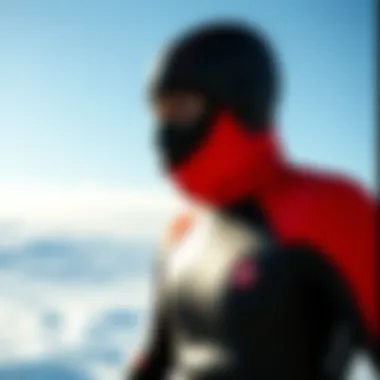
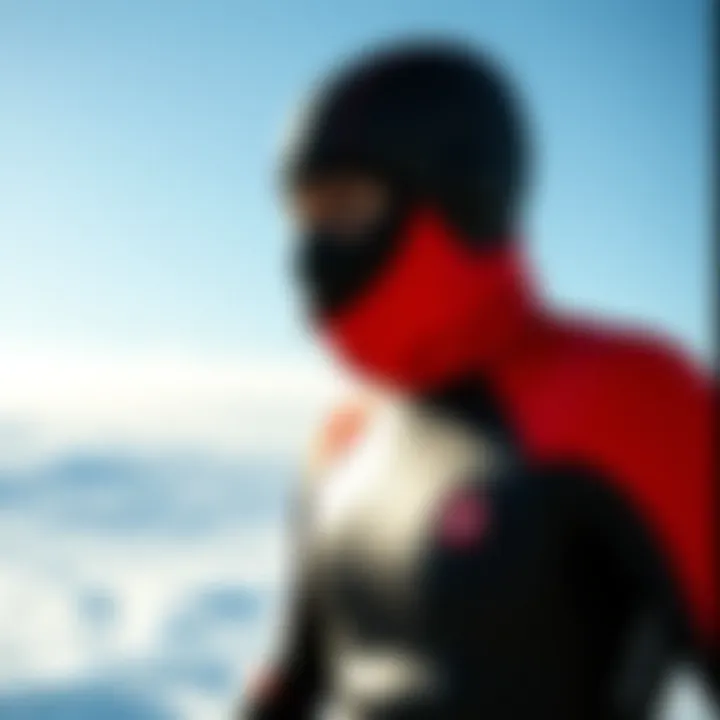
However, there are some disadvantages. Back zippers might let in more water, which can be a concern if you're in cooler climates. If you're in the mood for a simple, dependable choice, back zippers do well but be prepared for a bit of water intrusion.
Chest Zippers
Chest zippers have carved a niche for themselves as an increasingly popular option among kiteboarders. Positioned at the front of the suit, they offer more freedom of movement in the shoulders and reduce the chances of water seeping in at the back. This leads to a snugger fit overall, which can keep you warmer in cold waters.
The unique feature here is the design's streamlined nature; they typically create less bulk and reduce drag, making them a favorite for those serious about performance. Yet, getting in and out can be trickier depending on the particular model, and some users might find them a touch less convenient for quick changes.
Zip-free Designs
Zip-free designs stand out as an innovative aspect of modern wet suits. One significant advantage is that they are designed to eliminate all zipper troubles entirely. This can enhance comfort and reduce the risk of chafing and water leaks, providing an impermeable seal thanks to the flexible material used in construction.
Their snug fit might also enhance insulation, as they are built to hug the body closely. However, do bear in mind that getting in may require a little practice, since there are no zippers for assistance. If convenience is key for you, zip-free designs can be a game-changer, but be prepared for a learning curve.
Seams and Construction
Seams determine how well a wet suit will hold up against wear and tear and how effective it is at keeping water out. The method used in seam construction can influence the flexibility and durability of the suit, as well as your comfort during long kiteboarding sessions.
Flatlock Seams
Flatlock seams are among the most common seaming techniques. They involve sewing the fabric together in a way that lays flat against the body, reducing bulk and discomfort. This construction allows for excellent mobility and is often found in warmer suits designed for tropical waters.
The downside? They are less watertight compared to other seam types. If you're planning to kiteboard in colder waters, you may want to look for suits with more robust seam designs.
Taped Seams
Taped seams take the best of both worlds – they combine the flatlock method with an added adhesive tape applied to the inside of the seam. This helps to create a seal that prevents water from entering, making them ideal for cooler conditions. Taped seams usually mean a higher price, but this investment translates to a longer-lasting suit.
Yet again, this type does create a bit more bulk, so finding a balance between warmth and mobility might take some deliberation.
Blind-stitched Seams
Blind-stitched seams are a higher-quality construction method, designed primarily to keep water out. They feature a stitching method that does not penetrate the suit fully, thus reducing water entry. This technique provides excellent warmth and durability, allowing you to enjoy those cooler days without shivering.
The catch? They require a bit more care, as the construction tends to be more sensitive to wear. Make sure you’re ready to give it that extra TLC if you opt for a suite with blind-stitched seams.
The careful balancing act of features like zippers and seams can greatly influence your kiteboarding experience, so weigh your options thoughtfully for the ultimate ride.
Whether you're a seasoned pro or new to the sport, knowing the features and their implications will inform your choice and lead to enhanced performance and comfort out on those waves.
Common Myths and Misconceptions
When it comes to selecting a wet suit, separating fact from fiction is crucial, especially for kiteboarders. The market is flooded with information, and misunderstandings can lead to poor choices that impact performance and comfort on the water. This section aims to clarify some common myths that circulate about wet suits, helping enthusiasts make informed decisions. By addressing these misconceptions, we can ensure that kiteboarders find the right fit for their unique needs.
Myth: Wet Suits Are Always Cold
One of the biggest fallacies is the idea that wet suits are always cold. Yes, it's true that getting into a wet suit can be a chilly experience due to the initial dampness; however, that does not define the suit's actual thermal capabilities once you're in the water. Wet suits are designed to trap a thin layer of water against your skin, which then warms up due to your body heat. This insulation can keep you comfortable even in cooler waters.
The effectiveness of keeping warm in a wet suit largely depends on several factors:
- Thickness of the suit: Typically, thicker suits provide more insulation.
- Fit: A snug fit prevents cold water from flushing through the suit, improving warmth.
- Design: Some wet suits contain thermal linings that enhance heat retention even further.
It's vital to understand that a properly fitted wet suit can actually keep you warm without feeling like you’re freezing in your surfboard. Just remember, when choosing a suit for cooler climates, opt for something that fits snugly, is made from quality materials, and provides appropriate thermal insulation. This way, misconceptions about wet suits being cold will be a thing of the past.
Myth: Expensive Equals Better
Another prevalent myth is that the pricier the wet suit, the better it must be. While there is truth that investing in a high-quality suit can offer enhanced performance and durability, the price tag alone does not guarantee that it will perform better than a more budget-friendly option. This assumption could lead you down the rabbit hole of overspending without actually receiving proportional benefits.
When considering wet suits, think about these points:
- What are your needs?: Depending on your frequency of usage and the conditions you ride in, a more affordable suit might be entirely sufficient.
- Material and construction: Some mid-range suits are made from excellent materials that provide great warmth and flexibility, often rivaling more expensive options.
- Brand reputation: A well-known brand might charge more due to its reputation rather than actual superiority in functionality.
In the end, it’s essential to assess the performance aspects that you intend to prioritize in a wet suit, rather than simply opting for high-end brands. Doing a bit of research can save you a pretty penny while still ensuring you get a quality product that meets your kiteboarding needs.
"As a kiteboarder, knowing the truth about your gear helps you ride with confidence, knowing you’re prepared to tackle the waves rather than worrying about your wet suit."
In summation, dispelling these myths about wet suits can lead not only to better purchases but also to a more enjoyable kiteboarding experience overall.
Maintenance and Care
Proper maintenance and care of your wet suit are crucial for enhancing its lifespan and performance, particularly when engaging in kiteboarding. In this adventurous sport, it is more than just a piece of equipment; it's a gear that guards against cold waters while allowing freedom of movement. Without regular maintenance, wear and tear can lead to diminished performance and a more uncomfortable experience in the elements. Here’s an in-depth look at cleaning techniques and storage recommendations.
Cleaning Techniques
Rinsing after use
Rinsing after each usage is a vital practice for maintaining the integrity of your wet suit. After spending hours in the water, it can pick up a host of elements—everything from salt to sand. Simply rinsing the suit with fresh water helps to remove these contaminants, which can cause the material to break down over time.
What sets rinsing apart as a common recommendation is its simplicity and effectiveness. It acts as a barrier, protecting the suit from the adverse effects that saltwater can have on neoprene, including premature wear. A quick rinse after each ride preserves the suit's flexibility and extends its lifespan. On the downside, neglecting this step can lead to irreversible damage. So, make it a habit; a little rinse goes a long way.
"Rinsing your wet suit after every use is not just recommended; it’s essential to keep it in tip-top shape!"
Proper washing methods
When it comes to deeper cleaning, employing proper washing methods is a must. After several uses or if there’s a strong odor, consider washing your wet suit more thoroughly. Use a mild soap made specifically for neoprene to maintain its quality. Just mix it with water and soak the suit, softly massaging away any stubborn grime.


The unique feature of this cleaning method is that it not only keeps the suit fresh but also reinforces the neoprene’s flexibility. Harsh detergents, on the other hand, can damage the internal structure of the fabric. However, be aware that this method isn't meant for frequent use—doing it too often can wear down the suit’s material.
Storage Recommendations
Avoiding UV exposure
When it comes to storing your wet suit, one of the main considerations is avoiding UV exposure. Prolonged sunlight can break down the neoprene, leading to fading and cracking. For kiteboarders who want their gear to last, keeping the suit out of direct sunlight while storing it is key. This practice saves you both time and money by preventing early wear and prolonging the suit's usability.
A shady storage spot, like a closet or garage, is a much better option compared to a sunny corner of the yard. While UV exposure isn’t the immediate enemy after one day on the water, the cumulative effect can be significant over the course of a summer, leading to a decreased performance.
Hanging versus folding
Lastly, the debate between hanging and folding comes into play when it’s time to store your wet suit. Generally speaking, it’s better to hang your suit rather than fold it. This practice helps maintain its shape, especially around the shoulders where folds can cause stress points that might lead to tearing over time.
However, if you’re working with limited space, folding is a practical option, but remember to do so carefully, ensuring that no sharp creases are formed. Keep in mind that even slight distortions can affect fit and comfort on your next ride.
Epilogue
Taking the time to properly maintain and care for your wet suit is essential, not only to ensure comfort and performance while kiteboarding but also to prolong the life of the equipment. By following these cleaning techniques and storage recommendations, you will keep your wet suit in optimal condition, ready for your next adventure on the water.
Additional Accessories
When it comes to kiteboarding, your wet suit is just the tip of the iceberg. The world of additional accessories plays a crucial role in enhancing your overall experience on the water. These extras not only provide comfort but also improve your performance while you’re riding the waves. From keeping you warm to ensuring a solid grip, these components can make a significant difference in your time on the water.
Hoods and Boots
Temperature regulation
In the sometimes frigid waters, hoods and boots become an essential part of your kiteboarding gear. These accessories are designed to help you manage body heat and maintain comfort in chilly conditions. When the temperatures dip, keeping your head and feet warm is vital, as they tend to lose heat quickly. The key characteristic of good hoods and boots is their thermal insulation, which traps heat while allowing moisture to escape. This combination prevents that uncomfortable clamminess you can get with lesser-quality accessories.
One unique feature of these items is the use of specialized materials, like 3mm thick neoprene, specifically crafted for warmth. When it’s cold out there, having that extra layer can be the difference between a good session and a short one. However, it's also important to note that some people find hoods restrictive, which might distract from your focus on riding, so it’s important to find a balance between warmth and comfort.
Complementing the wet suit
Boots and hoods are designed not to overshadow the performance of your wet suit, but to complement its functionality. These accessories work in tandem with your suit to ensure a seamless experience while kiteboarding. For instance, when your wet suit offers buoyancy, pairing it with the right hood can ensure that you retain warmth without any unnecessary weight dragging you down.
The highlight of these accessories is their ability to improve mobility and ease of movement. You can find styles designed with flexibility in mind, permitting a full range of motion while enhancing thermal protection. However, it’s worth mentioning that not all hoods and boots are created equal; picking options that might be too bulky can limit your agility. Always be sure to try them on with your suit for the best fit!
Gloves
Enhancing grip and control
Another accessory that deserves the spotlight in kiteboarding is gloves. They aren’t just for keeping your hands warm; they are instrumental in enhancing grip and control on the kite lines, which is crucial for steering and catching air. Choosing gloves with a textured surface can really improve your hold, allowing for quick maneuvers and better reactions to changes in wind direction.
The signature feature of gloves designed for kiteboarding is their dexterity. A well-fitted glove provides protection without sacrificing mobility. Being able to feel the lines can be the difference between landing a complicated trick or being pulled off your board. However, there’s a trade-off; thicker gloves might offer more warmth but could hinder your ability to feel and control your gear as precisely.
Sizing and fit
The fit of your gloves plays a big role in how well they perform. A snug fit is essential for effective grip, but it shouldn’t be so tight that it constricts blood flow, making your hands cold or numb. Measure your hands accurately before making a purchase because a good fit helps in optimum performance. The key characteristic here is ensuring that there’s minimal excess material that could cause snagging or flapping, potentially leading to accidents.
Choosing gloves that fit well will improve your comfort level as you tackle each session. There are many sizes available that cater to different hand shapes, so look for brands that offer a range of options to find the best match for your hands. Plus, well-fitted gloves can decrease the likelihood of blisters or chafing, allowing you to focus on the thrill of kiteboarding rather than your discomfort.
In summation, accessories like hoods, boots, and gloves are not just add-ons, but essential tools that can significantly affect kiteboarding performance and safety. Selecting the right combinations can enhance your experience and help ensure that you enjoy your time in the water, tackling those waves head-on.
Making the Purchase
When it comes to kiteboarding, picking the right wet suit can feel like navigating a minefield. It's not just a matter of aesthetics; the right fit and features profoundly impact your experience on the water. Whether you're slicing through waves or banking hard in the wind, a suitable wet suit gives you that layer of warmth and protection. So, it stands to reason that making an informed purchase is pivotal in ensuring not only comfort but also your performance in kiteboarding.
Where to Buy
Local Shops
Local shops can be a real treasure trove for kiteboarders. Walking into a shop, you can see, touch, and try on the wet suits, which allows for a more personal approach to your selection. The most significant benefit of local shops is expert advice. The staff often has hands-on experience and can recommend wet suits based on your specific needs.
Additionally, you might stumble upon seasonal sales or local brand promotions that you wouldn’t find online. That being said, inventory can be limited compared to online options, so it's good to know what you are after before stepping into a store. If they have sizing charts available or fitting rooms, try a few suits—you really wanna feel how they sit around your body.
Advantages of buying from local shops:
- Personal touch: You get direct interaction with the staff and their expertise.
- Immediate availability: No waiting for shipping.
- Community support: Buying local helps your community flourish.
However, on the downside, some local shops may not offer the same variety when compared to online retailers, which can be frustrating if you’re looking for something specific.
Online retailers
Online retailers present a whole different ball game. The sheer range of options out there is mind-blowing. Just think about it: whether you’re after a full suit from O’Neill or a shorty from Rip Curl, you’ve got it all at your fingertips. An additional perk is the potential for better prices, especially during sales events.
Buying online gives you access to a wealth of reviews from other users, lifting the fog around which suits perform best under various conditions. But, this convenience also comes with some challenges. For instance, you can't try before you buy. The fit can be tricky, and returning something that doesn’t fit might mean a lot of hassle.
Advantages of buying from online retailers:
- Variety: A multitude of brands and styles that might not be available locally.
- Convenience: Shop at any hour without the pressure of salespeople.
- Competitive pricing: Often, you find better deals online.
Disadvantages can include:
- Sizing uncertainties: It can be complicated to interpret sizing charts.
- Shipping delays: Waiting for your new gear could mean missing good wind days.
Trustworthy Brands
Once you have decided where to purchase your wet suit, the next step involves identifying trustworthy brands to invest in. When looking at brands, consider their reputation in the kiteboarding community. Some of the most respected names include Quiksilver, Billabong, and Hurley. These brands usually have dedicated sections for kiteboarding gear, ensuring you receive products tailored for the sport.
Do not forget to look into each brand’s warranty and return policy, providing you peace of mind. It’s always a good idea to combine personal recommendations with online research. After all, it pays to choose wisely.

